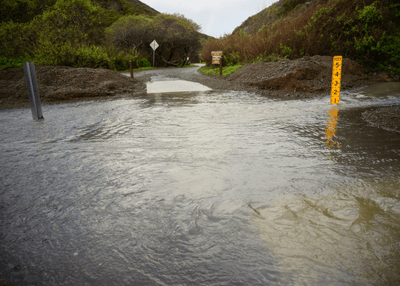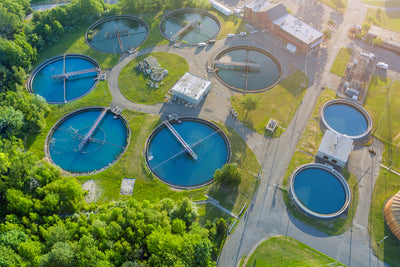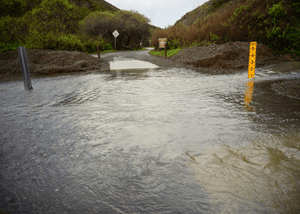Recent storms and atmospheric rivers can cause problems with drinking water infrastructure and both public & private water systems. Here's how you can protect yourself.
Water Quality InformationWritten By Actual Experts
RSSSevere Weather Can Impact Drinking Water Quality

What is a "Safe Level" for PFAS in Drinking Water?

How Does Deforestation Impact Water Quality?

Analies Dyjak, M.A. & Christina Liu, B.S., M.B.A.
Globally, we have lost one-third of the world’s forests, or 2 billion hectares (an area twice the size of the United States). More often than not, humans are responsible for deforestation. The land that surrounds a body of water plays a critical role in water quality and availability. Forested land not only acts as a “natural filter” for incoming water, but also reduces the risk of flooding.
What Is Deforestation?
Forested areas are cleared to make way for agriculture, commercial buildings, homes, and other large scale construction projects. Deforestation results in significant changes to the surrounding and global ecosystems, and habitat loss can lead to species extinction. The most extreme examples of this include the Amazon Rainforest, which has shrunk 18% in the last 40 years. Illegal mining, illegal logging, agricultural expansion, lack of government control, and climate change have all contributed to deforestation in the Amazon.
Deforestation has lesser-known secondary consequences that are becoming a focal point for scientists. Trees absorb carbon dioxide and release oxygen back into the environment. Without trees, the carbon accumulates in the atmosphere which contributes to rising global temperatures.
How Does Deforestation Impact Drinking Water Supplies?
Reduction in Rainfall and Global Implications:
Forests help control the water cycle by regulating rainfall and evaporation. The layers of the forest canopy, branches, and roots store and release water vapor, which helps to control rainfall. Forests also help reduce the impacts from flooding by blocking and slowing down the flow of runoff from storms. Deforestation, however, weakens this process, leading to irregular rainfall, including drought and flooding.
Also, while deforestation may occur locally, its effects are global. For example, in a 2005 study, deforestation of Central Africa caused a decrease in precipitation of about 5%–15% in the Great Lakes region, mostly centered in Illinois, with a peak decrease of about 35% in February. In addition, a 25% decrease in rainfall in Texas was attributed to Amazon deforestation. While the three major forest basins do not respond the same, deforestation in other areas have also been observed to cause changes in rainfall and the water cycle elsewhere in the world. The decrease in rainfall combined with the increase in water usage across the United States are contributing to severe drought and aridification throughout many states.
Increased Erosion and Runoff:
Forested land does a lot of the “heavy lifting” in terms of filtration. Soil absorbs pollutants and helps to slow the rate of flowing water. The tree roots also anchor soil against erosion, which reduces runoff, and lowers downstream water treatment costs. When forests are disturbed and degraded, (from deforestation or wildfires or a combination of the two), sediment flows into streams and pollutes water.
Reduced Water Quality/Access to Drinkable Water:
Scientists conducted a study in Malawi on deforestation and water quality. They found that when deforestation increased 1%, it was equivalent to a nearly 1% decrease in access to clean water, which was equivalent to a decrease in rainfall of nearly 10%. They also observed that access to source water did not mean people had more drinkable water. Deforestation increases soil erosion, resulting in higher soil, sediment, and turbidity levels in the water, increasing the need for drinking water treatment.
Over 60% of Toxic Wastewater Biosolids Are Used To Fertilize Farmland in The U.S.

Why You Should Change Your Hydroviv Water Filter Cartridge Every 6 Months

Eric Roy, Ph.D. | Hydroviv's Scientific Founder
Much like changing a car’s oil is necessary for a car to operate, replacing the cartridge in your Hydroviv water filter is necessary to ensure that your filter is producing safe drinking water for you and your family. This article discusses the most frequently asked questions that we get about cartridge replacement.
Why Do I Have To Change My Water Filter Cartridge?
The performance of a water filter cartridge against dissolved and particulate contaminants is dictated by two main factors: #1. pore structure and #2. active media blend. A water filter must be changed regularly because as water flows through the filter over time, the pore structure can become clogged with particulate matter and active media becomes saturated with chemicals. When the capacity of either is exceeded, the filter no longer performs as designed.
How Do I Know When It’s Time To Change My Water Filter Cartridge?
While it’s easy to tell if particulate matter has filled up the filter’s pores (flow rate slows down), it’s not as straightforward to tell if a filter has been saturated by dissolved chemicals without laboratory testing. This is where 3rd party testing & certifications come in. For example, as part of Hydroviv’s NSF Certification Program, our drinking water cartridges were shown to filter chemicals like PFAS, lead, and VOCs for over 720 gallons before performance tapered, which translates to a 6 month replacement interval for over 95% of Hydroviv customers.
What Happens When You Don’t Change Your Filters’ Cartridge?
When a filter is used beyond the capacity, filtration performance drops and can reach a point where the filter can release contaminants into the water, a process known as “avalanching.” This is why we tell people that if they decide not to replace the cartridge, they are better off disconnecting their filtration system.
Are There Other Factors That Create Exceptions to The 6 Month Rule?
While over 95% of Hydroviv users are best served by a 6 month replacement interval, we do have users that use a longer or shorter changeout interval. For example, a filter used by a large family that drinks a lot of water or has a high amount of particulate matter could require more frequent cartridge replacements. Conversely, an occasionally-used filter can probably be changed out less frequently, though we don’t ever recommend letting any filter be used for over 9 months for hygiene reasons.
This video shows how easy it is to replace the cartridge in your Hydroviv filter.
Other Articles We Think You Might Enjoy:
Here's why you shouldn't drink or cook with water from the hot side of your faucet:
Stop using TDS/ppm meters to test the quality of your water
Why home water filters are better for the environment:






